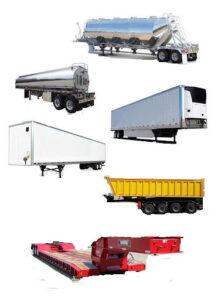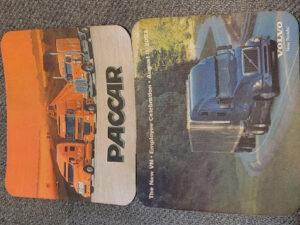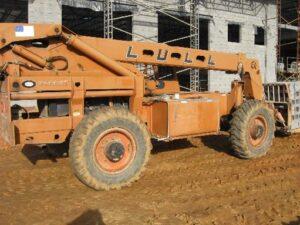
-
Overview
We are starting a series of articles on heavy trucks. Trucks are the manner in which most things are delivered to us, at least in part. Trucks are not immune to technological changes and regulatory demands. Often these two go hand in hand.

The world kept moving during Covid, albeit a bit slower, and that was due to commercial vehicles and truck drivers. These vehicles haul everything, from industrial manufacturing equipment, vehicles, fuel and other liquids, and consumer products, everything. The vehicles travel in the frozen reaches of the globe, as well as deserts and that can be the same vehicle that experiences these stimuli. Truck updates and the trailers builds are not on the same schedule, which means modern trucks must be backward compatible, that is can haul a modern trailer, and an earlier trailer perhaps more than 20 years older. This requires any vehicle update to consider the interfaces that reach back into history.

-
Industry Morphing
Vehicles have constantly under pressure to technologically change. Technological advances, demands for performance improvements, safety improvements, and responding to regulatory and competitive pressures. There are demands upon the vehicle that are well beyond that of passenger car or as we call it pas-car. For example, heavy trucks are commercial vehicles, that is, money is generated from the use. These vehicles are business investments. These vehicles carry heavy loads, and are required to cover long distances between service intervals. Where a passenger car goes 100,000 miles over the course of a decade or so, these commercial vehicles might do that in less than a year.

-
Combustion not much electric – nor data
We have been developing products for the heavy industry since the middle 90s. Even in those days the heavy vehicle (commercial vehicle) industry was much more mechanical than electrical and electronic. In fact, we once worked on a product where the vehicle starter was not electrical, but air, it was an air starter. The application was a vehicle working in petroleum industry, in the field, and it seems there was a history of electrical starters emitting sparks potentially leading to disasters.
-
90s Increasing electrification
Technology has been progressing on the vehicle, some of which has been legally mandated, for example the emissions (from the exhaust) ABS trailer status to the cab, and many others. Couple this with modern electrification, as versions or variants of the vehicles can also be electric rather than petroleum powered. Vehicles are costly, and to produce at an acceptable cost for the customer, the design will have common systems where possible rather than two completely different vehicles. Besides some material costs reduction due to component volume, common subsystems help with the maintenance, product aftermarket support, and more. As demand for electric vehicles increases, we will see the electrification in the non-electric vehicles to also increase.
-
data bus – engine and transmission
Back in the olden days, when Wally and I were working at a Skunk Work type product development organization for the heavy truck industry. OEM representatives would come to this company with a technical challenge and we would work to solve. Sometimes with detailed specifications, and sometimes with little more than a definition of the problem. In those days, we had problems come to us that introduced the use of a new data bus on the vehicle, the CAN bus (SAE standard J1939). Modern vehicles have many of these type of data buses on the vehicle. These data buses often bound by hardware standards, and message standards. However, some of these messages broadcasted via these serial communications links are non-standard or proprietary.
-
90s Explosion of modules (ECUs)
Once communications standards moved to faster and more complex standards, there became an explosion of electronic control units (some folks call them electronic control modules). Wire harnesses can carry heavy current loads long distances. These harnesses add weight to the vehicle and have difficult in routing the wire harness throughout the vehicle. These long wires carrying large currents over longer ranges present risks to short circuit via wire sheath chaffing or rubbing down to the wire. These short circuits of heavy current are potential fire risks. Weight and fire risks are the types of risk we work to reduce.
-
Other Standards
Besides technical standards for vehicle serial communications, we have standards for physical interfaces between the vehicle and the trailer. Standards attempt to reduce cost and guarantee interfaces are repeatable. Standards make interfaces predictable. When working with a variety of trailer types reliable interfaces are what makes the myriad of combinations work. The businesses that use these vehicles and transport cargo benefit, it is one of the reasons that make a productive business possible.
- RP1210
- J2638 – 5th wheel
- J560 – connector to trailer
- J1609 brake airlines
-
Throes of another technology change
Vehicles are much more complex, and more coming. There are driver assist and driverless systems being introduced, and ever expanding vehicle data available for both the owner and operator along with the OEM. There are more changes than these new driver support systems. Technological changes with the propulsion systems, that is moving from diesel powered to electric. Even for vehicles that remain powered via internal combustion engines, heavy electrification of the vehicle systems are well underway.
-
Ecosystem of Stakeholder
Those using the equipment, do not have the same priorities of those the use the product to earn a living are different. We call it ecosystem, because the vehicle consists in many context outside the manufacturing. We have people that use the vehicle and systems, there are a variety of ways to maintain the vehicle available to the customer.
-
Customers / Fleet

-
Dwell time – vehicle moving versus not moving
First, we will start off with a description of dwell time. We use this phrase to identify the time the vehicle is not moving. There are many reasons for this dwell time, for example, maintenance, or perhaps we have no driver or customer task at hand.
Commercial vehicles can be expensive, for example, an over the road tractor can cost anywhere from $90k to more than $120K (or even more costly). The vehicles are purchased to make money. In circumstances where the vehicle is not moving cargo, income is not generated, and that is the reason for purchasing the equipment. Meanwhile, if the vehicle is financed or by undertaking debt, the payments are still required to be made. It is not easy to see why it is in our best interest to keep the vehicle moving.
-
Insurance
Besides expensive commercial vehicles, these vehicles haul expensive and caustic material. The amount of control we have over the vehicle and cargo, the type of cargo, actions we take to reduce risk, and the company’s history of risk events will impact insurance costs. The level of security of the cargo, and the company’s ability to exert control can help reduce the insurance cost contribution to the operating costs. Unsecured cargo will impact the type and insurance costs of the transportation costs.
-
Fleet / individual missions / individual assets owned
The things deemed important often depend upon where a person or organization sits in the stream of the events or processes. Fleets are a collection of vehicles owned by an organization; these are individual assets. Fleets use these individual assets to accomplish specific individual missions.
-
Ability to maintain the asset
The fleet owners often maintain and service the vehicle. Maintenance of the vehicle can contribute to the dwell time of the vehicle, and we want this to be as small as possible. Additionally, we want this maintenance work to happen when we wish, not due to a failure during operation leaving the driver and the cargo on the side of the road. Large fleets have their own vehicle maintenance facilities, and it is a more cost effective solution for the vehicle to be maintained in these facilities.
Modern complex systems have self-diagnostics capabilities, often extensive and allow prediction that enables maintenance before the vehicle failure is imminent. This diagnosis, can be accessed via direct serial ports, or telemetry systems, allowing the workshop to order parts and schedule the maintenance at a convenient time, not leaving the vehicle in duress at a time when the customer is expecting a delivery. Replacement of parts based upon performance rather than arbitrary time of use or distance provides a cost savings.
-
Costs
The vehicle owner of fleet owner, is concerned with the operational costs of the vehicle. A costly vehicle (asset) has been purchased to meet some customer need and provide revenue to the company. The operation costs of that vehicle will influence the measure of profitability.

-
OEM / Supply chain
I (Jon) have worked at a few of the OEMs in North America (PACCAR, Volvo Trucks North America). The OEM has different reasons for predictive diagnostics and telemetry systems. One of the reasons OEMs want to understand the actual application of the vehicle, to be able to identify vehicle abuse in the event of reported failures. There is more to it than that however. Many vehicle products are developed using standards, some are specific to the OEM, and others are external such SAE, for example J1455, an environmental standard that describes the stimuli to which a product can be subjected, members of the industry often develop these standards. From experience these standards have gaps, telemetry systems reporting data from the vehicle, it is not as easy to understand the range of applications and stimulus to which the vehicle is subjected. However, there are more important reasons with long term implications, specifically future vehicle designs. The things learned via the present vehicle will help in future vehicle development and product extension. Understanding component or subsystem use and environmental situations (for example temperature) provides a tangible base from which new or alternate versions of the product can be created and delivered to the customer.
-
Aggregate missions and performance
Vehicle manufactures have always relied upon field vehicle information. In the olden days, there would be key customers from which the OEM representatives will spend time with the fleets to learn things about the vehicle use. This relationship development is the way to gather information about the vehicle application and performance but comes with the limits associated – specifically verbal interpretation and reliance on recollection.

Many commercial vehicle OEMs have special processes for returned or failed parts in the field for large fleets. These parts will be returned, sometimes with chain of custody measures making traceability possible. The returned location may conduct some limited post mortem of the component when coupled with the vehicle ID number and use reports.
-
Efficiency and reliability of all missions
OEMs have a goal to improve the vehicle over time. During the development of the vehicle, the components subjected to a myriad of tests, from component to system, and from static to situational operations, the vehicle is tested in accordance to standards and expected or anticipated circumstances. However, the scope of this testing is limited, the real world is much more complicated to simulate, emulate or otherwise test in the span of developing the vehicle.

-
Costs
There is more to cost than the purchase, but operations as well. For example, the vehicle that has best fuel economy, may have an advantage over the vehicle with the lower purchase cost. The top costs for the fleet owners is the driver, tires and the fuel costs. The operation cost, including a reduced dwell or service time, are also areas for the OEM as this represents a competitive advantage.
-
Maintainability and support of the various vehicles
The users of the vehicles have a variety of approaches to maintaining the vehicle. Small fleets may have the vehicle serviced by external facilities. Other fleets have internal facilities that will undertake the maintenance. Some components on the vehicle might be propriety and therefore will require interactions of some sort with the OEM or OEM aftermarket entity.
-
Extensibility of future vehicle platforms
Barring market surprises, the OEM will have an arc of the features and capabilities the vehicles will have over time. This will be an amalgam of the market trends, future regulation, and specific vehicle differentiators. To meet these future expectations, the present design of the product must allow for future adaptations, the easier the better. This is referred to as extensibility, or the ease of the product to be adapted for these future applications, and applies top software especially.
-
Regulations
There are many applications for commercial vehicles. The vehicles will be hauling through snow and deserts, paved and weather worn dirt roads that would vibrate a vehicle until the bolts loosen. Fleet vehicles can be subjected to this entire range of environmental events, or conversely operate in a very narrow range of stimuli. This range of variation is not often predictable, and why some vehicle will experience some type of failures while others will not.
Vehicles and vehicle manufacturers are bound by a variety of regulations and regulatory bodies. There are safety features and performance expectations, for example, the ABS systems. These and many other features will also be bound by legal requirements.
There are also safety standards by which the developed product is to conform, for example Functional Safety ISO 26262. This approach ensures the way the development of the product has been pursued, that there is an appropriate level of diligence commensurate with the risk the product could pose to the customer.
-
Overlapping and conflicting interests and priorities
Product development, from experience, is a balance of priorities within the constraints. The OEMs have interests in the final product beyond the profit margin and the costs. Future vehicles are built upon the present platform. Most vehicles are not an entirely from scratch development, but an increment from an existing platform. Of equal importance is how the customer deploys the vehicle and vehicle future feature content. In our following articles we will go into details of future changes to the tractor and trailer interfaces.











More Stories
Venti Technologies Wins Multiple Pinnacle Awards for Innovation and Achievement in Technology
Launch of AltaScient.ai: New horizons for Risk and Sustainability Analytics
Expert Tips on Detailing a Car